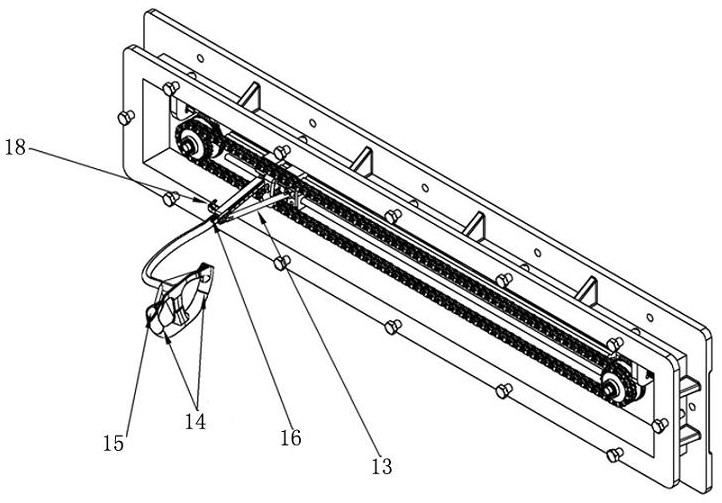Stair climbing power assisting device and method
A power-assisted device and stair-climbing technology, which is applied in the field of life assistance, can solve problems such as complex structure, large volume of chair elevators, and the lack of universal applicability of electric stair-climbing wheelchairs.
- Summary
- Abstract
- Description
- Claims
- Application Information
AI Technical Summary
Problems solved by technology
Method used
Image
Examples
Embodiment 1
[0081] Under normal environmental conditions, the processor of the induction controller uses a low-cost STM32F103C8T6 single-chip microcomputer, and the usage scenario is the process of going up stairs:
[0082] The user first hangs the weight on the hook 18, then holds the handrail 6 with both hands and pushes it upwards. The handrail 6 is subjected to an upward thrust along the stairs, and the handrail 6 bends upwards under the action of the thrust at this time. This bending deformation causes the distance between the two differential capacitance plates of the acceleration sensor in the induction module 17 to become smaller, and the change data is transmitted to the induction controller through the wireless module, and then controls the servo motor 1 to rotate forward. Now the transmission mechanism starts to work, and the armrest 6 moves upwards under the drive of the servo motor 1 . At the same time, the resistance value of the stress sensor in the induction module 17 chan...
Embodiment 2
[0084] In a more extreme environment (such as -20°C), the processor of the induction controller adopts the S7-1200 industrial PLC that can be used in a relatively harsh environment. The usage scenario is the process of going up stairs:
[0085] The user first hangs the weight on the hook 18, then holds the handrail 6 with both hands and pushes it upwards. The handrail 6 is subjected to an upward thrust along the stairs, and the handrail 6 bends upwards under the action of the thrust at this time. This bending deformation causes the distance between the two differential capacitance plates of the acceleration sensor in the induction module 17 to become smaller, and the change data is transmitted to the induction controller through the wireless module, and then controls the servo motor 1 to rotate forward. Now the transmission mechanism starts to work, and the armrest 6 moves upwards under the drive of the servo motor 1 . At the same time, the resistance value of the stress senso...
Embodiment 3
[0087] Under normal environmental conditions, the processor of the alarm controller adopts STM32F407ZGT6 single-chip microcomputer and ESP8266 Internet of Things module. The usage scenario is when the user feels unwell during use:
[0088] The user holds the handrail 6 with both hands, and when climbing up the stairs, when he suddenly feels unwell, he can press the one-key alarm button 16 on the handrail 6, and after the processor of the alarm controller receives the one-key alarm signal, it will pass The ESP8266 IoT module sends the stair position and floor position of the elderly to the management room, and connects the voice to communicate with the elderly to help the elderly out of danger.
PUM
 Login to View More
Login to View More Abstract
Description
Claims
Application Information
 Login to View More
Login to View More - R&D
- Intellectual Property
- Life Sciences
- Materials
- Tech Scout
- Unparalleled Data Quality
- Higher Quality Content
- 60% Fewer Hallucinations
Browse by: Latest US Patents, China's latest patents, Technical Efficacy Thesaurus, Application Domain, Technology Topic, Popular Technical Reports.
© 2025 PatSnap. All rights reserved.Legal|Privacy policy|Modern Slavery Act Transparency Statement|Sitemap|About US| Contact US: help@patsnap.com



